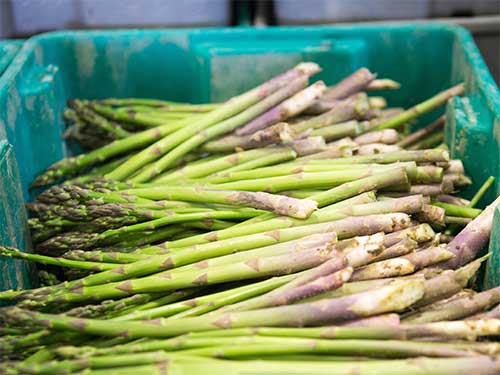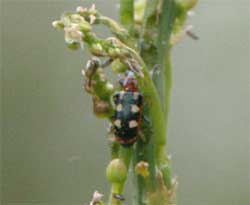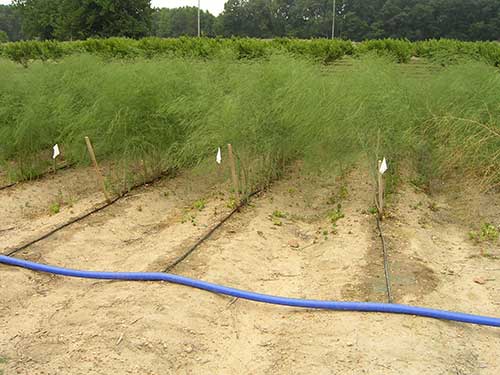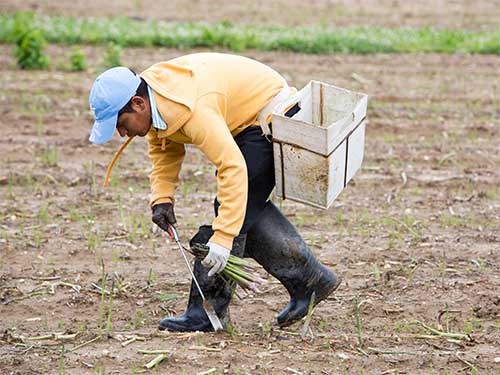
Fact Sheet FS1301
Ultra-Niche Crops are defined as exceptionally high-value crops that can provide a significant source of income to the farmer while using minimal land area.
Asparagus (Asparagus officinalis) is a perennial crop that can thrive for 15 years or more when well-cared for. However, asparagus requires a high initial investment and ongoing maintenance costs and offers no net income until the third or fourth growing season. After the field is established, maintenance costs are minimal compared to annual vegetables. Therefore, it is essential to carefully plan your marketing, production, and harvesting goals to establish and sustain a financially successful long-term asparagus operation on a small acreage farm.
Marketing
Who Will Buy the Crop?
It is important to recognize and understand your target customers and base the size of the asparagus acreage on market potential. Asparagus may be marketed successfully through roadside markets, pick-your-own, restaurants, CSA programs, or farmer's markets. The number and quality demands of targeted customers must be considered to determine acreage. Asparagus attributes such as spear length, diameter, tip quality, and spear color must also be taken into consideration.
How Suitable Is This Crop for Agritourism?
Asparagus is an excellent crop to offer to roadside stand and farmer's market customers because it is one of the early season highlights in New Jersey. Asparagus helps to sell and compliments other early crops such as strawberries and bedding plants.
How Well Does This Crop Withstand Shipping?
Asparagus withstands shipping well when cooled and boxed correctly.
What Packaging Should Be Used?
Asparagus should be packed vertically into ventilated shipping containers that can withstand moisture and prevent the spears from damage. Allow space between the top of the spears and the box cover. The spears will continue to grow in the box and if head space is not provided, the spears will curve.
Farmer's Tool Box
Essential Equipment/Supplies
Optional Equipment/Supplies
- Cooling or storage facility
Crop Requirements
Soil
Asparagus is most productive when grown on deep, well drained sandy loam soils. Asparagus plants lose vigor, become more susceptible to root rot, and ultimately die in poorly drained areas or following prolonged high rainfall. The soil pH should be maintained between 6.5 and 6.8. Medium to high fertility produces the highest yield and quality asparagus.
Water
Adequate soil moisture is important during the first growing season. Weekly applications of irrigation sufficient to wet the soil 8 inches deep should be adequate. After the first growing season, asparagus plants do not require frequent irrigation because of the deep and extensive root system. Thorough watering (2 inches of water) slowly applied every two weeks during dry weather is usually sufficient. Insufficient soil moisture in periods of dry weather may result in subsequent reductions in yield.
Light
Asparagus grows best under maximum photosynthesis conditions: a long growing season and sunny days in full sunlight. Ideal daytime temperatures during the growing season are 75° to 85° F with night temperatures from 60° to 70° F.
Frost Damage
Early spears can be frost damaged which results in dark-colored spears that collapse within 24 hours after frost exposure. Frost injury can be reduced by ridging soil onto raised beds when preparing the field in the spring, selecting a variety that emerges late, or selecting a site that has heavier soils that warm more slowly, thus delaying spear emergence beyond the threat of frost.
Growing the Crop
How Is Asparagus Started?
Plant healthy, certified 1-year-old crowns; never use 2- or 3-year-old crowns. Crowns should be kept cool (under 40° F) to prevent dehydration and bud growth during storage. An alternative to purchasing commercial asparagus crowns is to grow your own crowns from seed. Select and obtain high quality seeds or crowns of a male hybrid variety that has been tested and performs well in the Mid-Atlantic area. Avoid inter-planting small and large crowns because the large crowns will tend to out-compete small crowns and may prevent the long-term survival of the small crowns, leaving gaps in the stands. If crowns vary in size, sort small and large crowns, and plant like-size crowns in blocks.
What Is the Optimal Number of Plants per Acre?
A 12-inch spacing on 60-inch row centers results in 8,712 crowns/A. A 15-inch spacing on 66-inch centers gives 6,336 crowns/A. The closer in-row spacing usually produces a higher yield during the first two or three harvest seasons.
Management
Year Prior to Planting Asparagus
Year of Planting
Year Two
Year Three and Beyond
How Is Harvesting Performed?
Spears grow 3–5 inches per day when temperatures are 80–85° F. Harvest all spears that are more than 9 inches above the soil level by cutting just below the soil surface with an asparagus knife. Some growers snap the spears just above the soil level. Unmarketable, small, and defective spears are cut and left in the field.
How Is Asparagus Graded?
The USDA has established size and quality standards for asparagus. High quality spears have tight bracts at the tip. Most markets prefer the standard 9-inch long, all-green spear. Spears for commercial markets are usually trimmed at the cut or butt end; sized by diameter into small, medium, large, and jumbo categories; and bundled into 1 or 1.5 pound bunches for retail sale. Some markets prefer spears of other lengths and diameters. Be sure to check with your buyer or customers to determine their preferences.
What Are the Postharvest Cooling and Washing Requirements?
Asparagus loses quality rapidly after harvest. Sugars are respired and converted to lignin fibers resulting in a loss of sweet flavor and an increase in toughness. It is essential to shade harvested asparagus and quickly move it to a cooler environment or the packing house to prevent moisture loss and heating. If spears are washed, the wash water should contain an EPA-registered sanitizer. Washed, trimmed, sized, and bunched asparagus spears should be placed at 35° F and cooled as quickly as possible following harvest. Asparagus can be stored up to 10 days if held between 32–36° F at 90–98% relative humidity. Maintain temperature at 35–40° F with high humidity during transit and display prior to sale.
Diseases and Controls
The most serious disease of asparagus is Fusarium root and crown rot, a soil-borne disease. Only disease-free seeds or crowns should be used. Planting infested seed or infected crowns can lead to a rapid buildup of the pathogen in the soil and crowns that will drastically reduce yields of the asparagus and permanently contaminate the field for asparagus planting in the future. Fusarium infects the root system, kills the feeder roots, and causes collapse of the storage roots and rot of the crown. As a result, shoots and ferns wilt, turn yellow, and die. Plant vigor declines, spear size and yield decreases, and weaker plants may die.
Fusarium can be identified by the reddish-brown color of the feeder roots, reddish-brown spots and streaks on the storage roots, large reddish lesions on the base of the spears and stalks at or below the soil line, and wilting and die-back of maturing shoots.
These symptoms are much more severe when the plants are under stress due to excessively long harvests, poor drainage, competition from weeds, and damage from insects and foliage diseases. Planting new vigorous asparagus varieties that are adaptable to local conditions and reducing plant stress will help minimize the damage from Fusarium root and crown rot.
Asparagus rust is another common fungal disease. The fungal pathogen appears on the surface of stems and branches as small rust-colored elliptical spots containing spores that facilitate the spread of the disease. The asparagus rust fungus causes premature yellowing and death of the foliage. In the fall, the rust-colored areas produce black, overwintering spores that can infect the plant the following year. Severe rust infestations can destroy much of the foliage and reduce the yield of the next year's crop. Rust can be partially controlled using fungicides. New hybrid varieties that have some rust resistance will reduce reliance on fungicide applications.
Insects and Controls

Figure 1: Common Asparagus Beetle.
Several species of aphids, mites, and thrips are often a serious problem, especially on smaller or younger plants. They damage plants through feeding, sucking plant juices, and causing the green needles and stems of the young plant to turn dull gray-green, yellow, and die. Insecticides can be used to control aphids and thrips.
The common asparagus beetle (Figure 1) is a serious pest every year. Adult beetles are ¼ inch long with shiny black wings that have red margins and three yellow spots on each wing. They overwinter in debris in and around the field. In the spring they emerge, feed on spears, and lay rows of small, black elongated eggs on the spears and foliage. Spears contaminated with beetle eggs may be unmarketable. The larvae (small, dark green worms) do the actual damage by eating the green fern, thus reducing photosynthetic area, plant vigor, and yield. Beetles can kill very young seedlings and seriously damage ferns of mature plants. Asparagus beetles can be controlled by insecticides.
Considerations for Organic Production
Can Asparagus Be Grown Organically?
Organic production of asparagus is challenging due to increased time commitment and high labor costs associated with weed control and the lack of effective organic pest controls.
Organic Weed Control Considerations
Organic Insect and Disease Considerations
Critical Considerations
One of the biggest issues farmers need to consider when growing asparagus is site selection. Asparagus can be productive for 15 years or more, so the investment in land, time, and location is critical to success. Asparagus should be planted in sandy loam or loam soils with very good surface and internal drainage. Select a field that has not previously been planted in asparagus for at least ten years. Evaluate the field for perennial weed populations as they can seriously affect the quality and quantity of the crop and harvest.
Resources
Photo credits: Top row l - r: Tom Orton (asparagus), Tom Orton (asparagus field), Fred McGrady (asparagus harvest); Rick VanVranken (Figure 1).
March 2019
Copyright © 2024 Rutgers, The State University of New Jersey. All rights reserved.
For more information: njaes.rutgers.edu.
Cooperating Agencies: Rutgers, The State University of New Jersey, U.S. Department of Agriculture, and Boards of County Commissioners. Rutgers Cooperative Extension, a unit of the Rutgers New Jersey Agricultural Experiment Station, is an equal opportunity program provider and employer.



